Footage on Mt. Shasta by Hiking Nerd in 2018 and 2019
- Share via
MT. SHASTA — The couple from Seattle had a taste for adventure but little alpine experience, so they hired Jillian Webster, a professional mountain guide, to help them climb Mt. Shasta — one of California’s most dramatic peaks.
The trio crawled from their tents partway up the mountain at 2:30 a.m. on June 6 and set out for the summit. Snow and rain had forced climbers to turn back the day before, but that Monday the weather was nearly perfect, so clear one of Webster’s clients remembers looking to the heavens and being awed by the sight of the Milky Way.
With crampons on their boots and ice axes in hand, they spent hours kicking and clawing their way up the snowy route known as Avalanche Gulch. They did not know that, up ahead, an extremely hard, slick layer of ice was waiting for them at the worst possible place, on the steepest section of the climb at about 12,000 feet elevation.
When they reached that stretch, one of Webster’s co-workers from Shasta Mountain Guides, who was a little farther up the slope, shouted down that it was too dangerous and he was turning his clients around, according to Nick Meyers, the U.S. Forest Service’s Lead Climbing Ranger on Mt. Shasta.
The other guide looked away, briefly, and upon turning back, he was horrified to see Webster and her clients sliding down the mountain.
It’s unclear who slipped first, but it happened suddenly. Tied together for safety — a controversial practice called “short roping” — they all were yanked off their feet in an instant and hurtled down the slope with terrifying speed.
One of the clients, a 32-year-old software engineer, remembers his face slamming into the ice and somebody screaming. He tried to self-arrest — a technique he’d practiced days earlier in which a climber digs their ice ax into the snow to act as a brake — but that didn’t work because “it was just an ice field,” said the engineer, who agreed to share details of the tragedy if his name were not used.
- Share via
Within hours, a perfect morning turned into one of the most hectic and gut-wrenching days on Mt. Shasta in recent memory.
He felt one final glimmer of hope when his ax penetrated the surface, but by then they were moving so fast, “it ripped out of my hands,” he said.
“I remember kind of looking up the mountain as it just shoots away from me. I realized there was no stopping what was happening.”
The three fell “damn near 2,000 vertical feet,” said Meyers. That’s farther than anybody he can remember in his 20 years conducting rescues on the mountain. He blamed the ice. When conditions are like that, the slightest slip can be lethal.
“You cannot fall,” Meyers said.
Within hours, that perfect morning turned into one of the most hectic and gut-wrenching days on Mt. Shasta in recent memory. Aside from Webster and her two clients, two other climbers plummeted down Avalanche Gulch; all fell more than a thousand feet and all suffered serious injuries. Webster, 32, was pronounced dead shortly after noon.
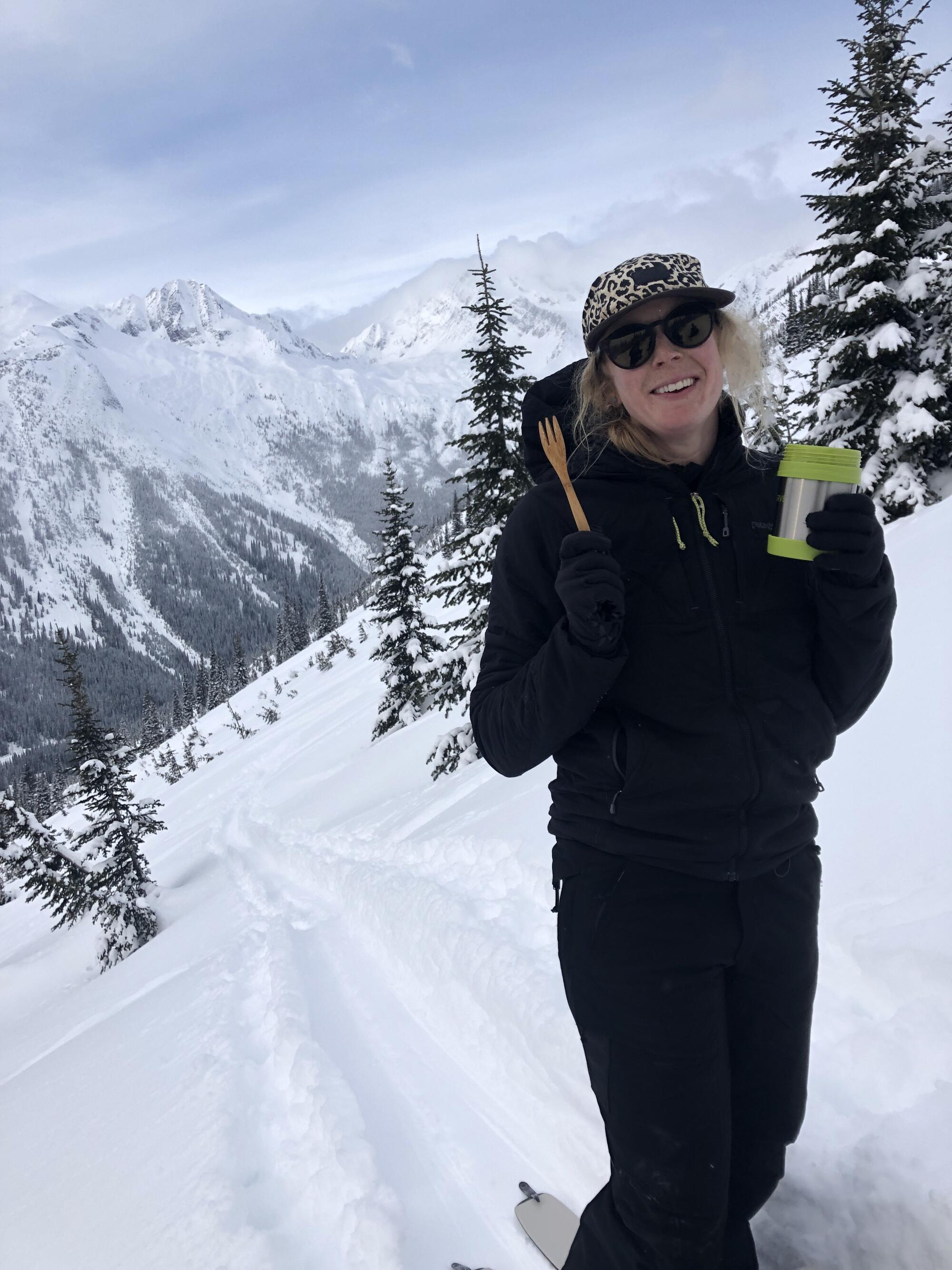
Dozens of other climbers have perished on Mt. Shasta over the years, but Webster’s death shocked the climbing community and raised questions about the growing popularity of summiting this peak. Are beginner climbers properly trained? And what are the risks to guides and emergency responders if they are not?
Big mountains “are like these living, breathing entities that change their mood at the drop of a hat,” said Pete Takeda, a climber and author who collects and edits accident reports for the American Alpine Club.
“One minute you can have an area that’s really nice snow and you’re just walking around and it’s super gentle.” The next minute it can turn “vicious and spiteful.”
Shasta isn’t the tallest mountain in California; that distinction goes to Mt. Whitney, about 500 miles south. At 14,505 feet, Whitney is the nation’s tallest mountain outside Alaska and, consequently, is one of the most sought-after summits in the country.
The vast majority of people who attempt Whitney stick to a well-worn trail. It’s a monster of a hike — 21 miles round trip with more than 6,000 feet of elevation gain. But in good weather it requires no technical mountaineering skill and can be done in a sturdy pair of trail runners.
Newsletter
The Wild
Meet us in The Wild, our newsletter about the great outdoors. Every week, we’ll take you along on the soft-dirt trails around L.A. as well as the cement-topped spots where nature incredibly thrives.
Impressive as it is on paper, Mt. Whitney isn’t much to look at. Surrounded by other 14,000-foot-high peaks in a long, jagged wall of granite at the southern end of the Sierra Nevada range, it’s hard to even pick it out from Lone Pine, the nearest town.
At 14,179, Mt. Shasta is only a hair shorter, but it’s a stunner. A massive, snow-covered volcano rising alone above the northern end of the Central Valley, it looks as impressive as some of the grandest peaks on Earth. But unlike Everest or Kilimanjaro, which require long journeys and huge outlays of cash to reach, Mt. Shasta’s trailhead is only a few minutes’ drive off Interstate 5.
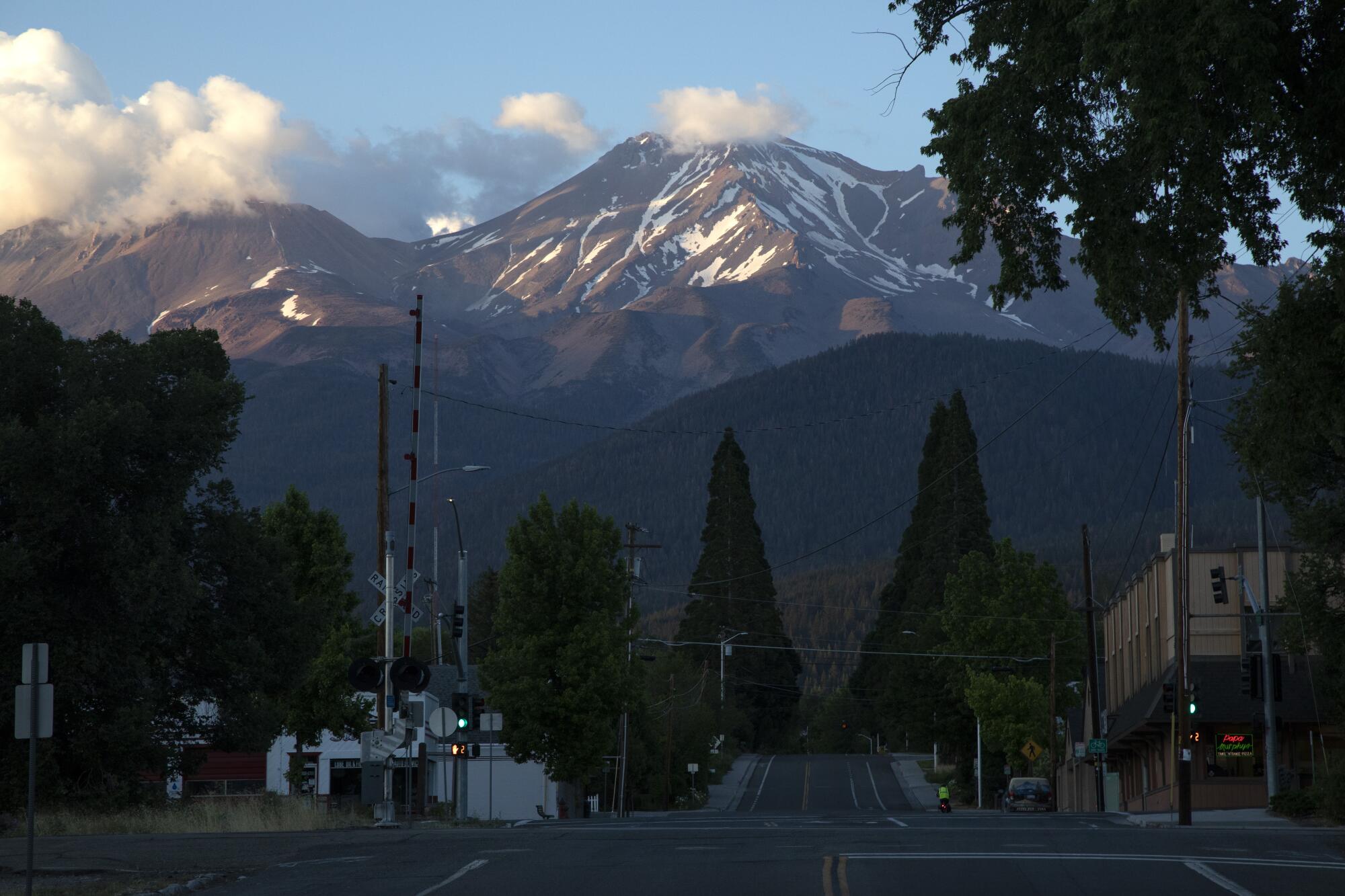
That’s a big part of the appeal but it comes with a caveat. “It obviously attracts a lot of novice climbers,” Meyers said.
Hiking experience does not prepare you to climb Shasta. Even the easiest route, Avalanche Gulch, requires crampons and ice axes most of the time. They aren’t expensive or particularly difficult to use, but becoming proficient enough to save your life in a sudden fall takes practice. If you’re hurtling down an icy slope, you don’t have time to learn.
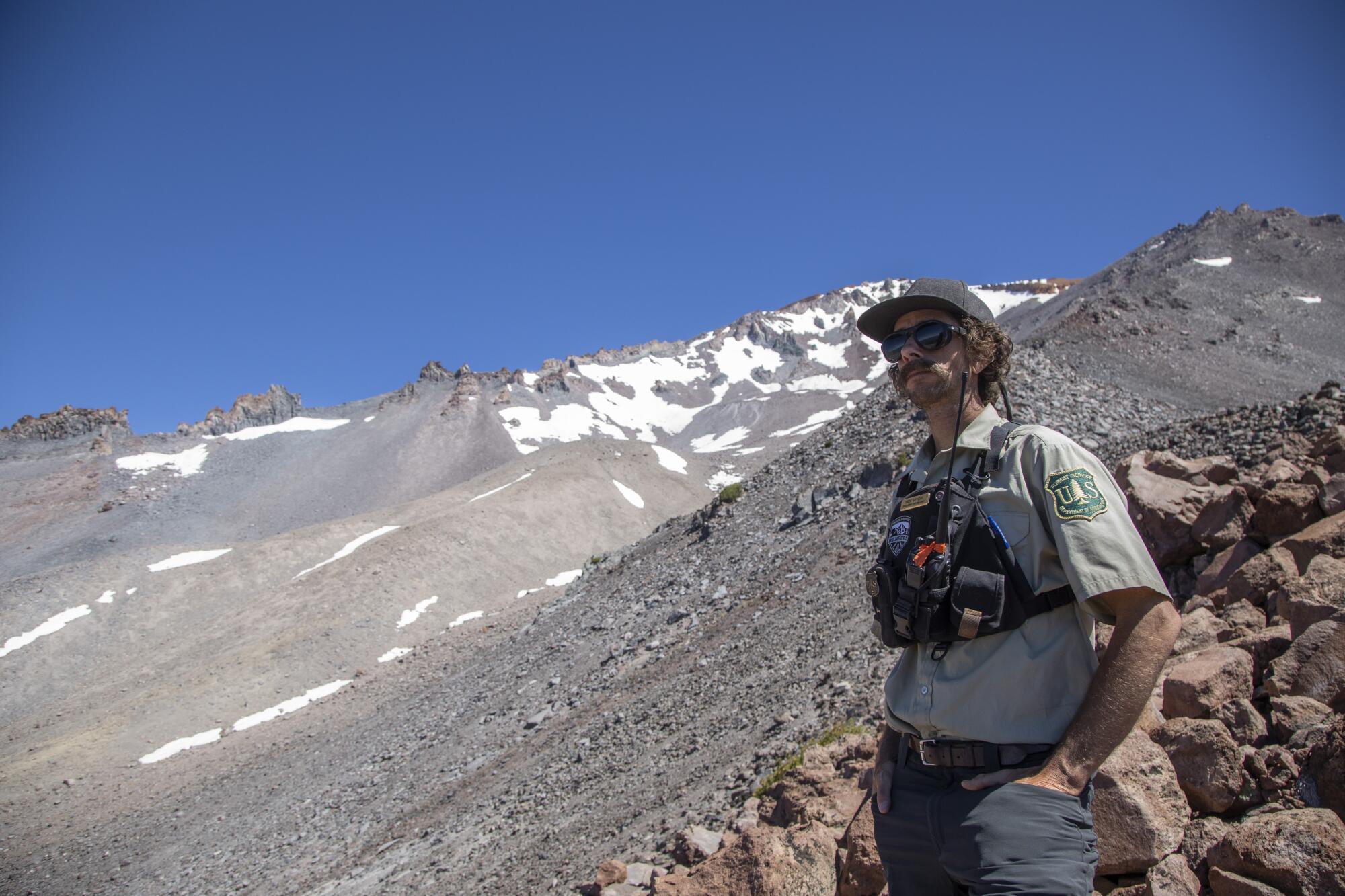
About 6,000 people attempt to reach the summit of Shasta each year, usually in the late spring and early summer, when the snowpack is most stable and inviting. The vast majority traverse up and down without serious incident, but local emergency services are forced to make about a dozen rescues per year and there’s one fatality on average, Meyers said.
Many of the people on Shasta are experienced mountaineers. Some climb with skis on their backs so they can click into their bindings near the top and glide down thousands of feet without taking a single step.
Many others are beginners who watch a few YouTube videos — if that — and try to wing it. Two of the climbers who had to be airlifted off the mountain on June 6 fell into that category. They were “grossly unprepared,” Meyers said.
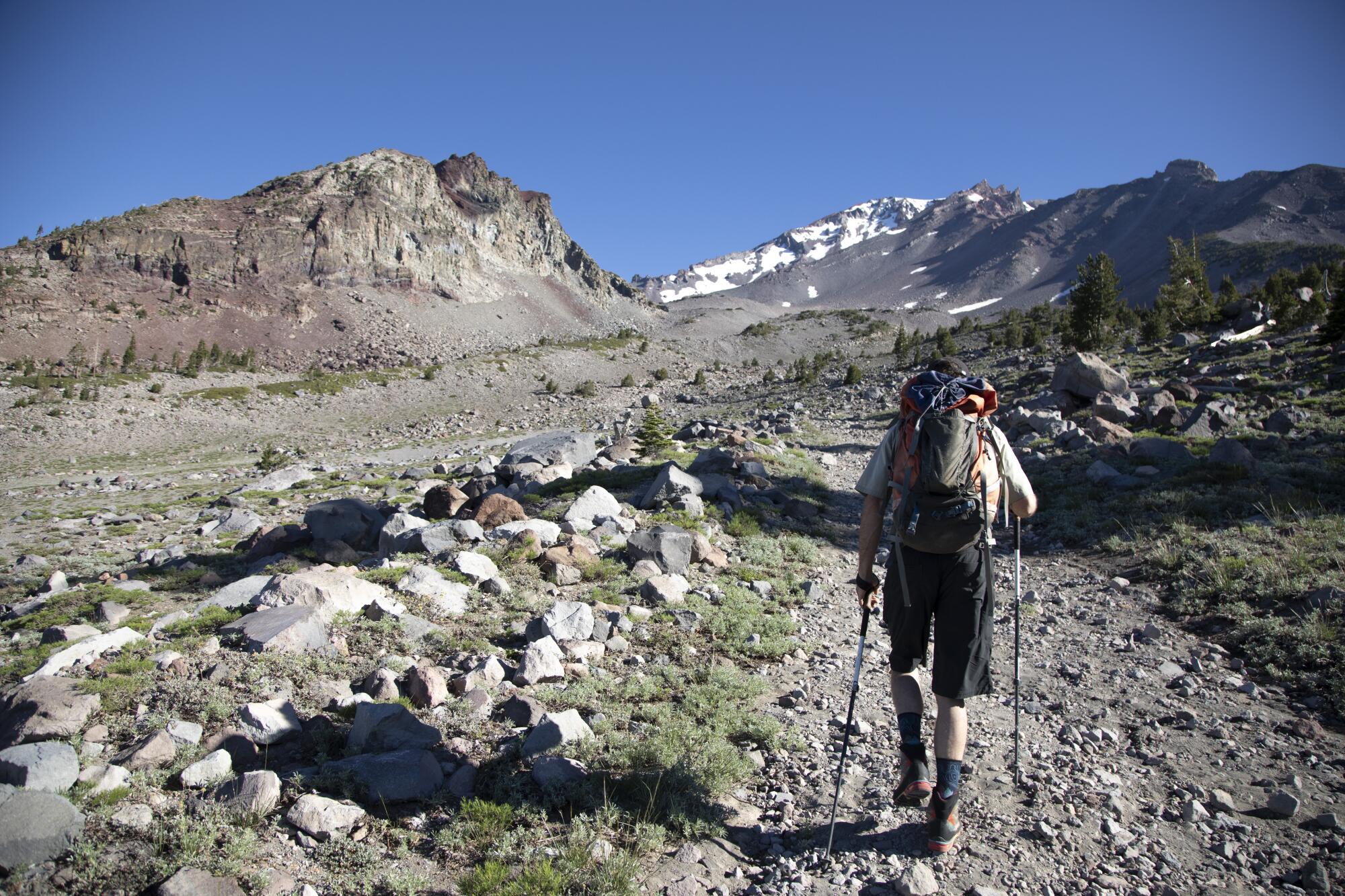
A growing number of climbers, like Webster’s clients, hire professional guides and enroll in weekend mountaineering courses. Demand for guide services on Shasta surged after COVID-19 vaccines arrived and people were desperate to do something big and adventurous outdoors. That demand hasn’t tapered off as things return to a semblance of normal. It’s still growing, guides say.
The clients are mostly young, relatively affluent tech workers from the Bay Area, said David Court, who has been leading people on mountain adventures around the world for more than a decade.
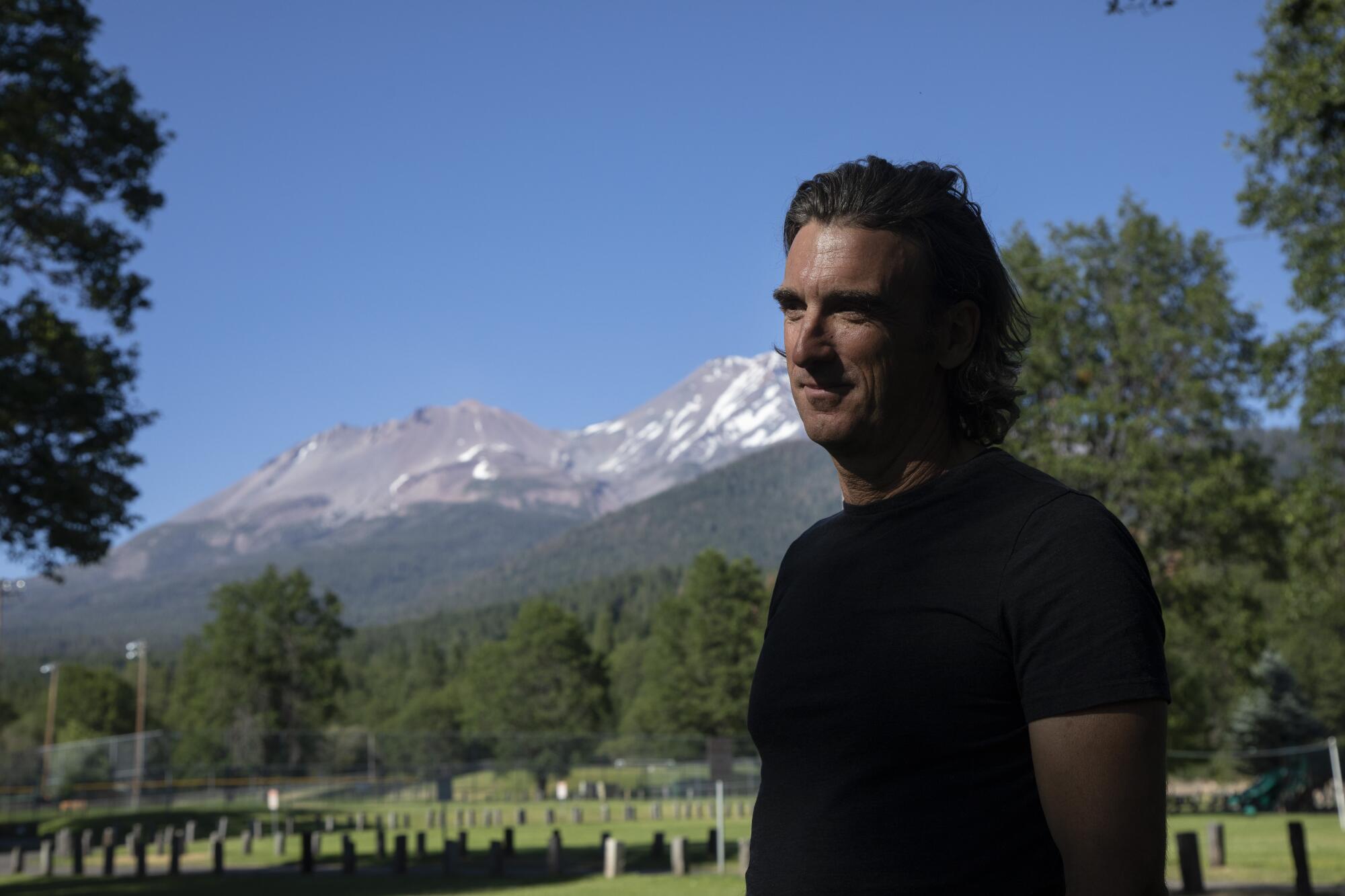
They spend long workdays writing code or trapped in endless Zoom meetings, so “they’re really, really looking for a way to get out, to get away from the computer, to get away from that grind,” Court said.
They’re also willing to pay. A weekend mountaineering course and summit attempt costs about $1,000 per person without tip. Unlike rugged, independent outdoorsy types of old, these young tech workers don’t balk at the price or see any shame in admitting they need professional help.
While hiring a guide is a good idea for anyone without solid mountaineering skills, it’s no guarantee nothing bad will happen. Learning to climb mountains is a little like learning to race motorcycles. You have to start slow or you could be dead before you get a chance to brag about it.
In 2018, I took a mountaineering class with Court on Matterhorn Peak — a remote, stunning Sierra Nevada summit that from some angles resembles its famous namesake in Switzerland. Jack Kerouac wrote about climbing it in his novel “The Dharma Bums,” adding a dash of literary cachet.
The climb up its snowy flank, via the East Couloir, is by far the steepest thing I had ever attempted. Despite the safety gear — crampons, ice axes, a rope tying us all together — I had to fight off a mild panic attack as I tried to plant my feet in Court’s boot tracks, using them like stairs as we slowly ascended the thousand-foot face.
“Most people’s anxiety comes as they’re going up,” Court said in a recent interview, noting that his trip with me was his first time guiding that route. “I remember I was thinking, ‘This is going to be tricky to come down.’ ”
He was right. There were three of us roped together for the descent. Another client in front, me in the middle, and Court as the anchor in back. Ideally, this short roping technique gives the strongest climbers a chance to save the weaker climbers if they fall. But it also puts everyone at risk because one person falling can easily pull everyone on the rope down with them.
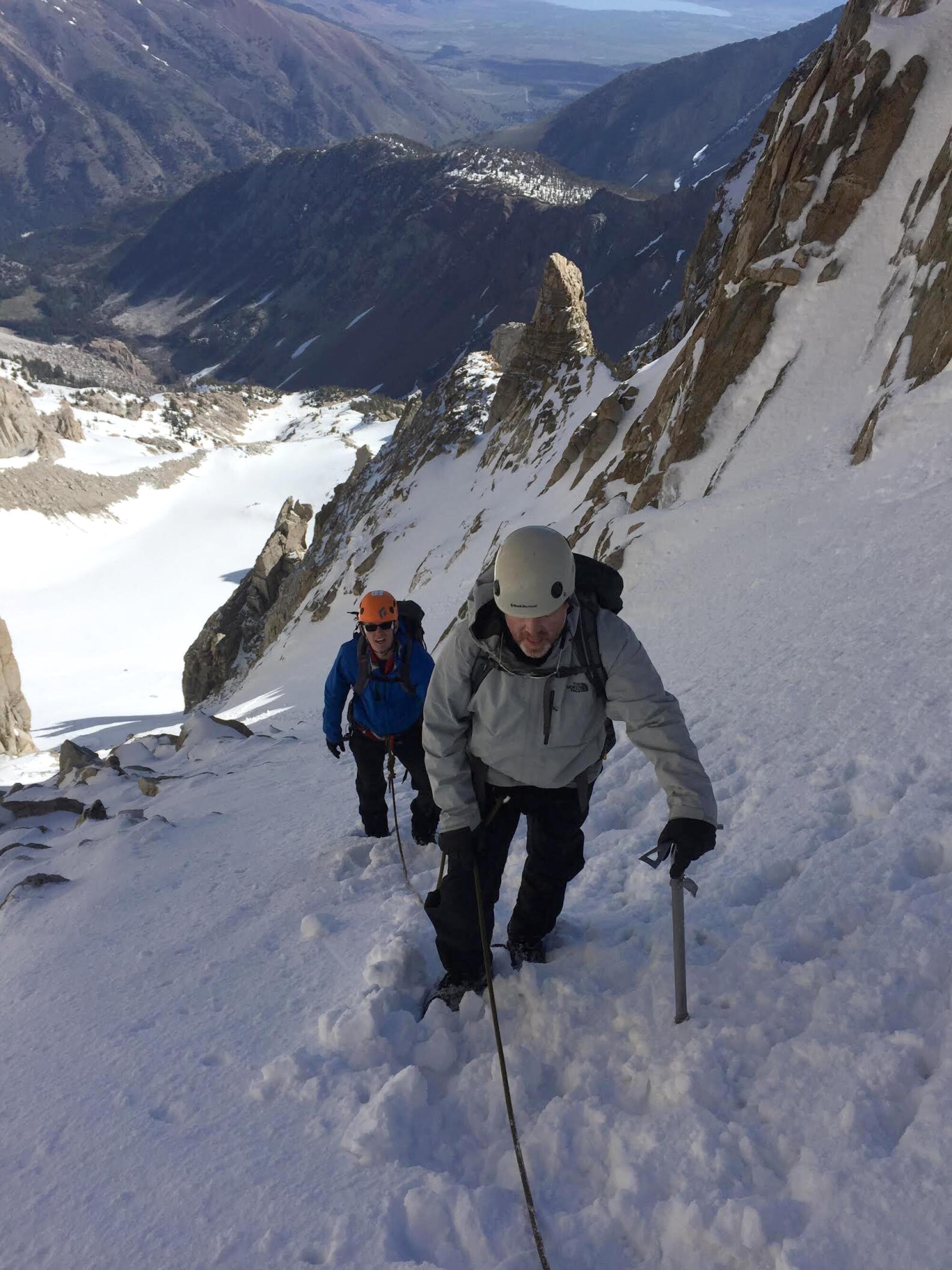
We didn’t make it very far before the client in front, who was staring straight down the thousand-foot slope, started to hyperventilate.
Court stepped forward and whispered in my ear to keep the rope tight because slack would create a sudden, violent jolt if he fell. As Court went back into the anchor position, I felt the rope cinch tight behind me.
After a few tense minutes, our companion seemed to calm down and started chatting about the view, which was glorious. I stopped worrying so much about slack in the rope.
That’s when I was yanked off my feet so suddenly I was sliding headfirst down the couloir before my brain could process why. My Gore-Tex outer layer offered no friction against the snow; if anything, it made me accelerate. It was like sliding on a garbage bag.
The threat of dying didn’t enter my mind until I looked left and saw Court sliding headfirst on his stomach past me. I remember the shock on his face and him screaming, “Arrest, arrest!!!”
I did what Court had made me practice over and over the day before: I spun around — more like squirmed and flailed — until I was falling feet first on my stomach. I got the ax beneath my chest and pressed with all my strength so the long, pointed end would drive into the snow just beneath my shoulder. Then I kicked, furiously, to get the points of my crampons as deep into the snow as they would go.
Court did the same. Suddenly — everything was still.
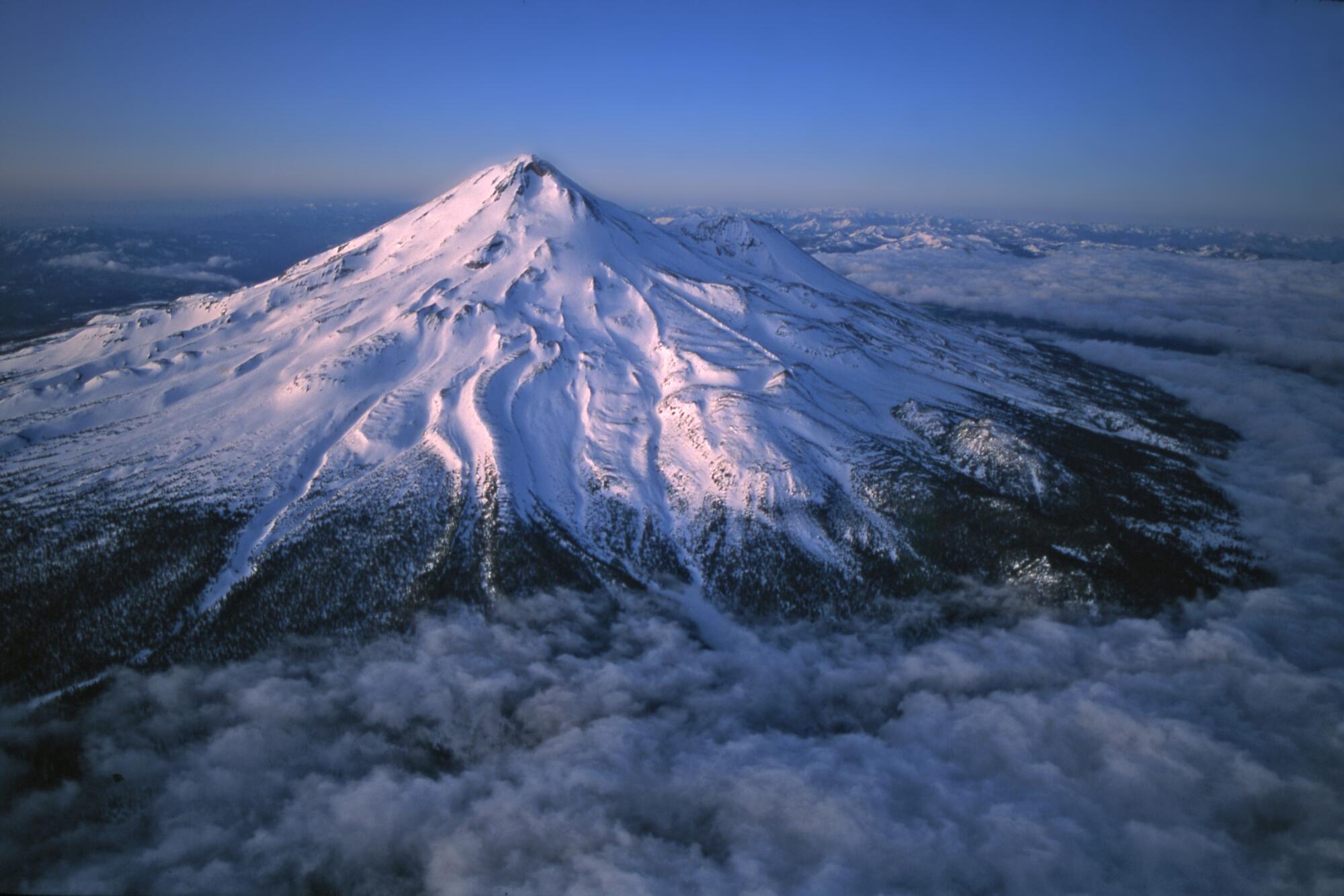
We’d slid hundreds of feet, but at first glance, all seemed OK. No head injuries or broken limbs. Our gear was intact. Then we noticed the bright red blood dripping in the otherwise pristine snow. In the chaos, somebody’s crampon had gone through the other client’s hand.
He was in a lot of pain. Court and I both felt guilty, but it seemed a small price to pay for our lives. Court bandaged the wound and stopped the bleeding; we were all able to walk out under our own power.
Court, who said he’d never had a close call like that with clients before, admitted that he too had been caught by surprise. “It’s amazing how you stopped paying attention for just a second, and then bam, you’re taking the ride,” he said.
In May of this year, I climbed with Court again. This time on Mt. Shasta, via Avalanche Gulch, a few weeks before Webster’s fatal fall.
Except for the 40 pounds or so of camping and climbing equipment in our backpacks, the first day was an easy stroll. We covered a couple miles and gained about a thousand feet. We camped in shallow snow beneath towering pine trees and played cards with the other guides and clients to kill time as we slowly acclimatized to the altitude.
The next day we hiked another 2,500 feet to Helen Lake, a broad, flat snow-covered plateau with a sobering view of the technical route that begins just above it. That was the first weekend with good weather in a while — severe wind had turned climbers away the previous weekend — so the camp was packed with the hopeful.

Subscribers get exclusive access to this story
We’re offering L.A. Times subscribers special access to our best journalism. Thank you for your support.
Explore more Subscriber Exclusive content.
As we dug deep holes in the snow to screen our tents from gusts, we gazed down to a lush, green valley thousands of feet below. Houses in the town of Mt. Shasta were tiny from that height, but still discernible. I fantasized about soft beds and dry socks.
We got an “alpine start” the next morning, at 2 a.m. The idea is to begin climbing when the snow is cold and firm beneath your crampons, tag the summit as early as possible, and then descend before the heat of the afternoon loosens blocks of ice and rock, turning them into potentially deadly missiles.
We had made it to the steepest part of the climb — where Webster and her clients fell — just as the sun rose. A photo of that moment is one of the cherished keepsakes of Shasta; the summit’s nearly perfect triangle casts its enormous shadow to the horizon.
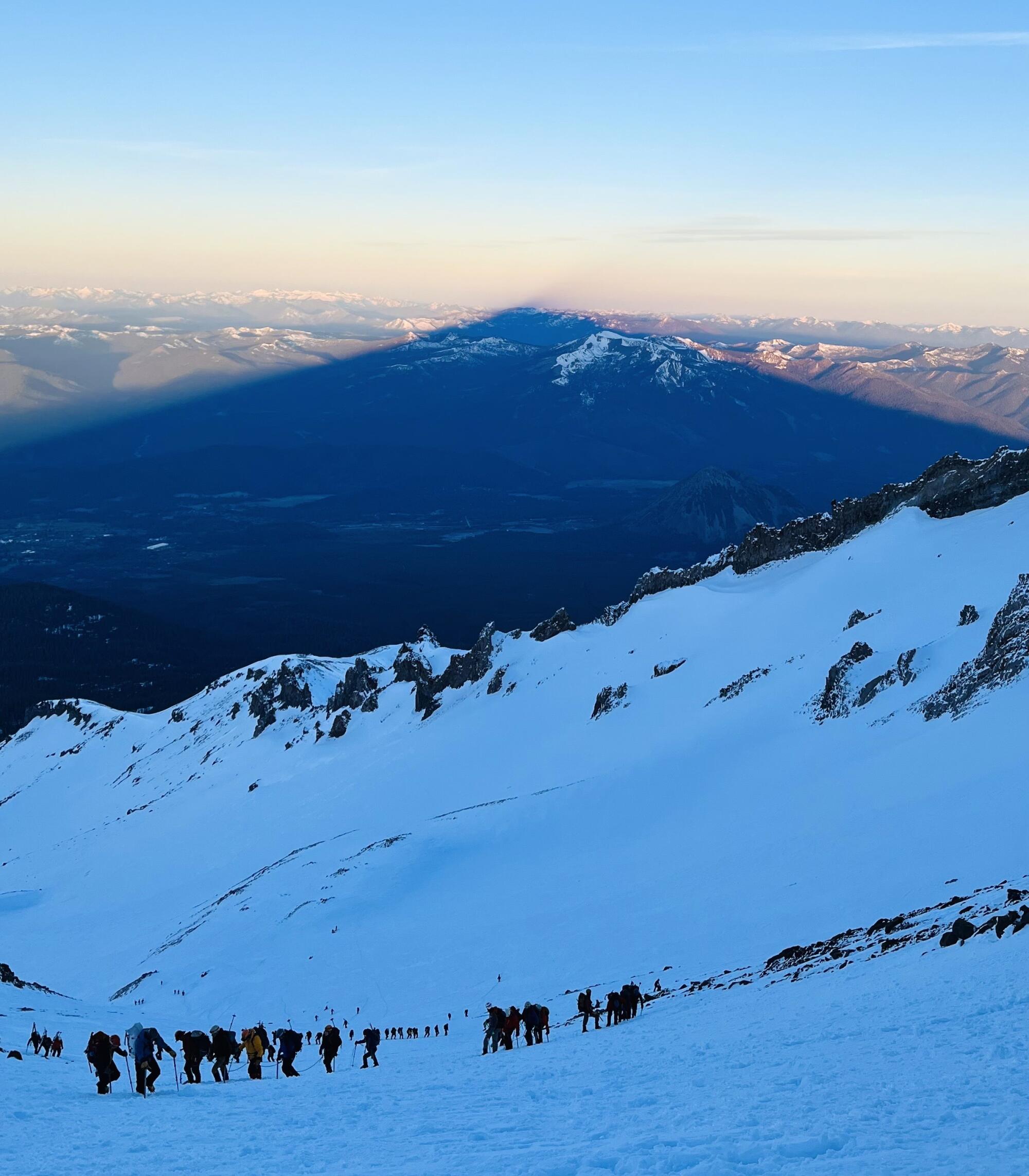
I was so focused on not dropping a glove, or my phone, which would have accelerated and sliced like a bullet through the conga line of climbers below, I failed to notice a telling detail in the photo I took. A long, horizontal shadow streaming off the summit. A more observant mountaineer might have recognized it as blowing snow — a lot of it — and a sign that we were climbing into howling wind.
We finally reached the summit at 9:40 a.m. The wind was gusting over 40 mph, so we didn’t stay long. We took a few photos, exchanged a few high-fives, and ducked low to avoid being blown off our feet as we started down. Several climbers from another group crawled on their hands and knees. I saw one guy crawling on his belly.
The wind dropped quickly as we descended. By 13,000 feet it was about half as strong as at the summit. As we reached the steepest section near 12,000 feet it had dissipated almost entirely.
In fact, it was so warm and the snow had become so soft that we removed our crampons, sat on our butts and slid down using our ice axes to steer and control speed. The technique is called glissading and it was a godsend after an exhausting day on our feet. We laughed like kids as we descended more than 2,000 feet — almost exactly the distance, and along the same path, as the fatal fall a few weeks later.
When I heard about Webster’s accident, I couldn’t wrap my head around the contrast in the snow conditions. For us, it had been so slushy we struggled to keep going; she couldn’t stop to save her life.
Everything started well on June 6. “It was a bluebird day,” the software engineer on Webster’s team said. “I mean, you’re going up this steep, icy slope, so it’s obviously scary, but it seemed OK.”
After hiking a few hours steadily uphill, they stopped to put crampons on their boots near Helen Lake. That’s where Webster pulled out the nylon climbing rope and helped her clients attach it to harnesses around their waists.
Roping up is one of the most “controversial and contentious” acts in climbing, according to Takeda. If he weren’t absolutely confident in a climbing partner’s ability, he wouldn’t tie himself to them even in moderate terrain. “You’re basically doubling the opportunity to fall.”
Jillian Webster’s older brother Jordan, himself an experienced climber, wonders if his sister would still be alive if they hadn’t roped up. The technique provides a “false sense of security” for the clients, he said, who spend maybe an hour practicing their self-arrest on low-angle terrain, but have no idea how fast things will happen in a real fall.
“If you can’t do it yourself, you probably shouldn’t be there,” Jordan said.
It’s unlikely that guiding companies will discontinue the practice, since the industry is built upon taking people to places they shouldn’t be on their own.
Nick Caselli, the operations director and senior guide for Shasta Mountain Guides, declined to comment for this story, citing investigations into the accident.
Webster remained attached to her clients for the entire fall, which covered 2,000 vertical feet and about a mile, probably in about a minute.
The guide who saw the fall radioed the news to a co-worker lower on the mountain and then began a slow, laborious climb down the icy slope to search for the victims. It took him about an hour.
He encountered a trail of lost gear along the way: an ice ax, a trekking pole, a crampon, a single black glove.
The co-worker he’d radioed found the victims first, several hundred feet below Helen Lake, with horrendous injuries. That’s when 911 was called.
Falls are common on Avalanche Gulch, but almost everybody stops on one of several flat spots higher up the mountain or, at worst, when they get to Helen Lake.
“So when the call first came in, and their location was mentioned, we were all scratching our heads like, how did they get all the way down there, and why are they so badly hurt?” Meyers said. Only later did rescuers realize how slick the slope had become.
A California Highway Patrol helicopter picked up Meyers and a fellow climbing ranger in town and whisked them to within a few hundred feet of where Webster and her clients came to rest.
Meyers said he found “a nightmarish scene.” The snow was streaked with blood and both clients’ bodies and faces were covered with road rash, as if they had been in a motorcycle accident on pavement. Each had a broken leg; the engineer’s ankle was so horribly shattered his foot was pointing the wrong way.
Rescuers packed both of them into specialized harnesses — known as “screamer suits” — and attached them to a long cable dangling beneath a helicopter. They were flown a safe distance from the mountainside before being slowly winched up into the helicopter for the rest of the flight to the hospital.

Webster, who outwardly looked the best, was in the worst shape. Her helmet was broken and there was a small abrasion over her left eye, but those were the only visible clues to the horrific head injury she’d suffered. She had been conscious but mumbling and combative when her co-worker found her. Her condition rapidly deteriorated.
When she stopped breathing, Webster’s colleagues and one of their clients — an operating room nurse and wilderness medicine instructor — took turns performing CPR on her for nearly an hour, to no avail.
Webster, who was raised in a passionately outdoorsy family in Thousand Oaks, spent her 20s living hand to mouth and working seasonal jobs — ski instructor, mountain guide — to finance her adventures. She had traveled to India and trekked in the Himalayas, traversed the Pacific Crest Trail from Mexico to Canada and skied daunting peaks in the Alaska backcountry, her brother said.
She was also about to quit guiding, he said. She had moved in with her boyfriend, renovated their house and taken a job as a preschool teacher, and seemed ready to try a more traditional life. She never got the chance.
Speaking from his home in Seattle, the software engineer said his girlfriend, who also did not want to be named, is doing well. Her broken ankle required surgery and is full of “plates and bolts,” but it is healing and she’s able to walk on it. His ankle, which is also full of surgical hardware, is pointing the right way again, but it still can’t hold his weight. He hopes to be able to start walking again in September, he said.
He has since learned that the ice he slid on has a nickname, “cascade concrete,” and he still had plenty of scars from it in early August, including open wounds on his elbows and knees. “The first thing anyone asks me when they see me at a store or something is if it was a motorcycle accident,” he said.
While he probably won’t strap on a pair of crampons or pick up an ice ax again, he doesn’t regret the decision to attempt Mt. Shasta or the way he and his girlfriend went about it. “We had the right gear, and we had some of the best Mt. Shasta guides in the business.”
He said he wouldn’t dissuade anyone from attempting to summit the peak, adding: “The mountains are beautiful.”
More to Read
Sign up for The Wild
We’ll help you find the best places to hike, bike and run, as well as the perfect silent spots for meditation and yoga.
You may occasionally receive promotional content from the Los Angeles Times.














